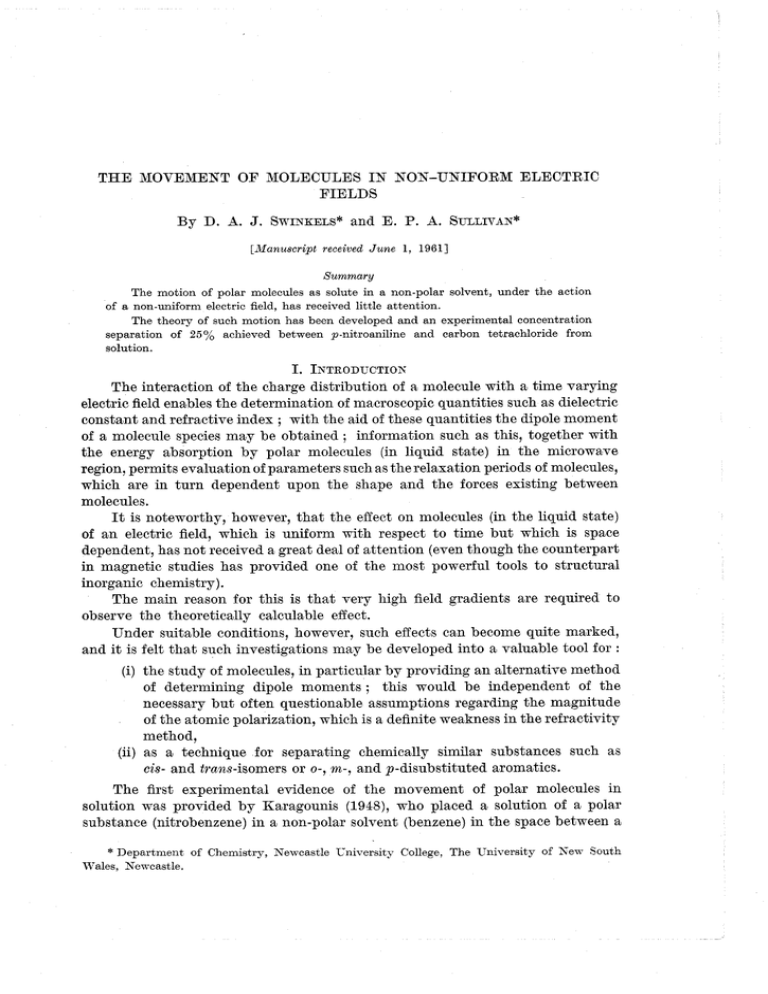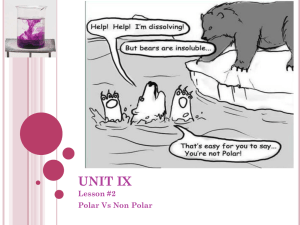THE MOVEMENT OF MOLECULES IN NON
advertisement

THE MOVEMENT OF MOLECULES IN NON-UNIFORM ELECTRIC FIELDS By D. A. J. SWINKELS* and E. P. A. SULLIVAN* [Manuscript received June 1, 19611 Summary The motion of polar molecules as solute in a non-polar solvent, under the action of a non-uniform electric field, has received little attention. The theory of such motion has been developed and an experimental concentration separation of 25% achieved between p-nitroaniline and carbon tetrachloride from solution. I. INTRODUCTIO~V The interaction of the charge distribution of a molecule with a time varying electric field enables the determination of macroscopic quantities such as dielectric constant and refractive index ; with the aid of these quantities the dipole moment of a molecule species may be obtained ; information such as this, together with the energy absorption by polar molecules (in liquid state) in the microwave region, permits evaluation of parameters such as therelaxation periods of molecules, which are in turn dependent upon the shape and the forces existing between molecules. It is noteworthy, however, that the effect on molecules (in the liquid state) of an electric field, which is uniform with respect to time but which is space dependent, has not received a great deal of attention (even though the counterpart in magnetic studies has provided one of the most powerful tools to structural inorganic chemistry). The main reason for this is that very high field gradients are required to observe the theoretically calculable effect. Under suitable conditions, however, such effects can become quite marked, and it is felt that such investigations may be developed into a valuable tool for : (i) the study of molecules, in particular by providing an alternative method of determining dipole moments ; this would be independent of the necessary but often questionable assumptions regarding the magnitude of the atomic polarization, which is a definite weakness in the refractivity method, (ii) as a technique for separating chemically similar substances such as cis- and trans-isomers or o-, m-, and p-disubstituted aromatics. The first experimental evidence of the movement of polar molecules in solution was provided by Karagounis (1948), who placed a solution of a polar substance (nitrobenzene) in a non-polar solvent (benzene) in the space betmeen a * Department of Chemistry, Newcastle University College, The University of S e w South Wales, Newcastle. 488 D. A. J. SWINKELS AND E. P. A. SULLIVAS wire and coaxial cylinder and applied an electric field between these electrodes. He observed that after some time the concentration of the nitrobenzene near the central wire was greater than in the bulk of the solution. This was not an electrophoretic effect, because reversal of the polarities on the electrodes did not reverse the direction of the increased concentration. The term " dielectrophoresis " was introduced by Pohl (1958)to describe the movement of polar molecules in non-uniform electric fields. 11. THEORY When an electric dipole is placed in a uniform eleotric field it experiences a torque, which tends to orient it in a direction antiparallel to the field direction ; there is, however, no resultant translational motion. If the field is non-uniform, one pole of the dipole will be in a stronger field than the other ; accordingly, the force on it will be greater than on the other pole and a net translational force results. Assuming that the applied field is non-uniform in the x-direction and decreasing with increasing x, the net translational force f, acting on the dipole moment rn (in the direction of x ) is : dl? f =rn-, dx where l? is the electric field intensity operating a t the site of a molecule. (There will be an induced moment m,=uP, where u is the mean polarizability of the molecule.) Permanently polar molecules, under the influence of the field tend to align themselves antiparallel with the field direction ; to estimate the actual degree of alignment, the concept of an average moment, directed in opposition to the field direction, is introduced. It is this average moment which is manifest in dielectric measurements. This average moment is defined by the expression pL(x), where p is the true dipole moment of the molecule and L(x) is the Langevin function L(x)=coth x -11% ; where x =@/kZ'. Accordingly, the total moment in the direction antiparallel to that of the field is N=d+@(x). Consider now that the field P is act,ing upon polar and non-polar molecules comprising a solution. Introducing subscripts p and lz for polar and non-polar molecules, we have, for the translational forces on polar and non-polar molecules : dl? f*=Mpdx thus dF = [t*L(x) +CCpPlz, MOTION O F MOLECULES I N NON-UNIFORM ELECTRIC FIELDS 489 This difference in force on polar and non-polar molecules (Af) is responsible for the separation of polar and non-polar molecules in a mixture. On applying the Boltzmann distribution law to (1): where Er is the daerence in energy between polar and non-polar molecules at r , where the electric field intensity is .Fr. Let the energy Merence between polar and non-polar moleoules at x = oo be zero. The energy di£€erencebetween polar and non-polar molecules when they are each brought to a position x=r is given by E.=-[ m ~fdr=-[ dl? 00 [pL(x)+(a,-~t,J.F]~.dr, It is pertinent to our subsequent discussion to note that for pP/kT'=0.7, L(x) M e r s from its approximate form, namely, pB'/3kT', by less than 4%. Applying this approximation to equation (3) and integrating we obtain Equation (2) thus assumes the form 111. EXPER~IESTAL The solution cell (Fig. 1)was constructed to approximate to a point electrode with concentric spherical outer electrode. The solution, consisting of polar solute in non-polar solvent, was placed into the electrode cell A and adjacent compartment B. The electrodes were then connected to the high voltage unit shown in Figure 2. Every few minutes mercury was allowed to drop from a capillary tube into vessel C ; this forced a small volume, equal to that of the mercury drop (of radius 0.02 cm), of solution in close proximity to the wire "point" electrode up the glass capillary into the upper compartment of A. When sufficient Liquid had been collected in this compartment, samples were taken from the upper and lower compartments of A and the concentrations of these solutions compared spectrophotometrically. The " radii " of the inner and outer electrodes were 0.01 and 1cm respectively. The solvent for each of the two solutes investigated was very dry carbon tetrachloride. D. A. J. SWIEKELS AKD E. P. A. SULLIVAN Fig. 1.-Solution cell. r-------I RUHMKORFFA INDUCTION COIL Fig. 2.-High voltage unit. v3, V4=1B36 valves ; C,, C,, C,, C,=0.002 pF 12 kV d . ~ .Wkg ; R,, R2=470 M a ; R,= 1000 M a ; ;$f=O-50 FA meter. VI, v2, MOTION OF MOLECULES IK NON-UNIFORM ELECTRIC FIELDS 491 IT. RESULTS The solute concentration increase for each of the four solutions studied is shown in Table 1. TABLE1 INCREASES I N CONCENTRATIONS O F SOLGTES I Solute and Concentration (g/l) I 1 I I Nitrobenzene (0.0216) Nitrobenzene (0.0517) p-Nitroaniline (0.0267) p-Nitroaniline (0.0267) .. .. .. Concentration Increases (%I I .. i The spectrophotometric curves for the last solution shown in Table 1 are igure 3. The absorbency of the initial solution, the sample taken from upper compartment of A, and the sample taken from the bulk of the solution were plotted over the wavelength range 260 to 390 m p to a8certain that chemical decomposition did not take place during the experiment. Fig. 3.-Spectrophotometric curves. Neglecting the polarizability terms, equation (4) may be written Identifying P, with the applied field intensity we may now calculate J, for example, for the last solution of p-nitroaniline, shown in Table 1. To determine 492 D. A. J. SWINKELS AND E . P. A. SULLIVAN P,, assume that the electrode system is that of a point electrode-spherical electrode. For such a system, the electric field intensity l?,at a distance r from the centre of the system is where V is the potential difference between the electrodes=50,000 V=166 e.s.u., r, is the radius of inner (point) electrode=O.Ol cm, r, the radius of outer electrode=l - 0 cm, and r=0 ~ 0 cm, 2 hence FT=4- 3 x lo3 e.s.u. Substitution of this value into equation (5)together with p=6 a5 x 10-Is e.s.u., k=1.38 x 10-l6 erg deg-l, l'=2 -90 x 10, deg gives J=eO.Osl=l .09 ; thus 9 % separation is predicted. V. DISCUSSION The theoretical aspects of this work include a number of assumptions : (i) The electric field is taken to be uniformly non-uniform in the x-direction. (ii) The calculation of electric field intensity acting at a molecular site neglects the effects of nearby molecules. (iii) Only the mean polarizability of a molecule is considered in the determination of the induced moment. (iv) The variation of electric field intensity over a molecular distance is neglected in the calculation of the induced moment. The experimental results support the theory in that concentration separations may be achieved in polar solute/non-polar solvent solutions. The separation (25%) of the solution of p-nitroaniline is much greater than that predicted ; this is probably due to : (a) the assumption outlined above, and ( b ) the fact that the distance, r, used in formula (6), was taken to be that of the radius of the drop of solution forced by the mercury drop into the " capillary " electrode: the magnitude of 3 is very dependent upon r. Perhaps it is worthy of note that the electrical analogue of the Gouy (magnetic) balance and the possibility of an electric moment chromatograph, each based upon the above theory, are being investigated. VI. REFERENCES KARAOOUNIS, C. (1948)-Nature 161 : 855. POHL,H. (1958).-J. Appl. Phys. 2 9 : 1182.

